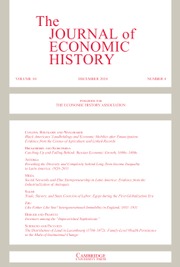Over 10,000 unique bank notes circulated throughout the United States before the Civil War. Issued by individual private banks, the notes were printed on different types and sizes of paper, and had face values ranging from a few cents to hundreds of dollars. Critically for transactions, the notes were often only accepted at a discount that varied dramatically across time and place. Scholars have examined the institutional details of how the bank notes were created and circulated, but Joshua Greenberg provides detailed accounts of the public’s daily experiences with them. Unlike today where people take currency at face value without a second look, individuals in the antebellum economy had to become monetary experts to avoid overpaying in transactions or receiving counterfeit notes. As a result, Greenburg is able to show how intimately ingrained bank notes were in American consciousness and culture.
The book is separated into three sections. The first covers the major players in the market and how bank notes were used in transactions, the second examines the physical nature of bank notes, and the third highlights how personal experiences with bank notes influenced political leanings and movements. Fitting the theme of the book, Greenberg advances each discussion by telling the narratives of individual people, firms, and even towns. Some of the more impactful descriptions take up whole pages in order to dive into the relevant background, motivations, and outcomes. Greenberg supplements personal stories with depictions of bank notes in literature, art, and music. The wide range of detailed accounts is a feat of archival skill that leaves a lasting impression with readers.
The narrative evidence paints a clear picture that bank notes were a necessary evil, and the public went into transactions with their eyes open. Individuals knew they were being hoodwinked by bankers, carpetbaggers, and counterfeiters, but lacking much federal currency in circulation, they needed bank notes to carry out transactions. For example, Greenberg relates how some towns protected the notes of failed banks from being removed from circulation, and even anti-money advocates accepted bank notes. Individuals took steps to educate themselves in order to reduce their disadvantage as much as possible. They scrutinized the quality of the artwork on the notes, signatures of the bank’s officers, and the paper stock. Each note told a story and individuals added to it, writing political slogans, poetry, advertisements, etc. on the blank backs of notes. Greenberg’s depictions show that bank notes were more alive to people than money today and that each transaction required a keen eye and careful negotiation.
The individual narrative approach allows readers to see through the eyes of the public, but leads to concerns over the extent that specific aspects can be broadly generalized. Like things today, the most astonishing stories get published and survive over time whereas common-place stories often get ignored. Making for an entertaining read, Greenberg focuses on sensational stories of fraud and counterfeiting on the frontier of banking, but it is hard to know how common-place such occurrences were in the developed parts of the country. For example, the book relates relatively little about the more stable bank note systems in the Northeast. Greenberg also draws some broader conclusions from specific narratives that are hard to judge. For instance, he highlights how the characteristics (e.g., gender, race, status, etc.) of the person using a note could affect the discount at which the note was accepted. The argument is supported by several anecdotes in the book, but it is hard to know that it was the case in most transactions. Greenberg thus makes a convincing argument that bank notes were personal to individuals in ways that have been often overlooked, but is not always able to justify generalizing some aspects of the narratives.
The book does not purport to cover any particular time period, and Greenberg arranges chapters by theme rather than date. Most chapters focus on bank notes before 1840 (though there are scattered examples going forward in time), whereas the last chapter discusses how the issue of greenbacks and standardized national bank notes during the Civil War replaced the chaotic bank note system. The approach misses the chance to examine the changes to the American monetary system taking place after the Bank War and Panic of 1837. During the later decades of the period, Free Banking laws were passed and advances in communication and transportation allowed more information to reach consumers. Others have studied the broader aspects of the changes, but the book misses the chance to highlight how they altered peoples’ experiences with bank notes and set the stage for their response to the Civil War monetary reforms.
Bank Notes and Shinplasters tells the narratives of how bank notes were ingrained in antebellum American consciousness and were eventually dislodged by more uniform currency. The story is entertaining and well-written; however, at various points, Greenberg leans on readers having some previous knowledge of the period’s major institutions and events. As such, it is best suited for those with at least some knowledge of the major events of the period but pairs well with the other antebellum studies that focus on the broader financial and political dynamics. Even scholars well-versed on the period, however, will learn from the book as it includes many details and points of view not contained in other studies.


